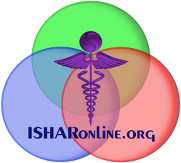Chinese Practices
List ISHAR Online Sources: Chinese Practices
View Interactive Timeline: Chinese Practices
Functional Summary
Modality |
|
Utilizes diverse combinations of Qigong exercises, herbs, massage, dietary restrictions, meditation and acupuncture. |
Intention |
|
Balancing flow of qi. Harmony of complete bodily functions > anatomical structures |
Geo-Cultural |
|
Traditional Chinese medical system dating to 1100 BCE. Widely used in China as a complementary medical approach, it is growing in popularity in Western countries. |
Definition
Traditional Chinese medicine ("TCM"; simplified Chinese: 中医; traditional Chinese: 中醫; pinyin: zhōng yī; literally: "Chinese medicine") is a broad range of medicine practices sharing common concepts which have been developed in China and are based on a tradition of more than 2,000 years, including various forms of herbal medicine, acupuncture, massage (Tui na), exercise (qigong), and dietary therapy.[1] It is primarily used as a complementary alternative medicine approach. TCM is widely used in China and it is also used in the West.
TCM "holds that the body's vital energy (chi or qi) circulates through channels, called meridians, that have branches connected to bodily organs and functions." Concepts of the body and of disease used in TCM have some similarities to European humoral theory. The doctrines of Chinese medicine are rooted in books such as the Yellow Emperor's Inner Canon and the Treatise on Cold Damage, as well as in cosmological notions such as yin-yang and the five phases. Starting in the 1950s, these precepts were standardized in the People's Republic of China, including attempts to integrate them with modern notions of anatomy and pathology. In the 1950s, the Chinese government promoted a systematized form of TCM.
TCM's view of the body places little emphasis on anatomical structures, but is mainly concerned with the identification of functional entities (which regulate digestion, breathing, aging etc.). While health is perceived as harmonious interaction of these entities and the outside world, disease is interpreted as a disharmony in interaction. TCM diagnosis aims to trace symptoms to patterns of an underlying disharmony, by measuring the pulse, inspecting the tongue, skin, and eyes, and looking at the eating and sleeping habits of the person as well as many other things.
Recent Research
The 2015 Nobel Prize in Physiology or Medicine has gone to Youyou Tu, a researcher who spent her entire career researching traditional Chinese medicine. Based at the Chinese Academy of Traditional Chinese Medicine in Beijing (AKA the China Academy of Chinese Medical Sciences) since 1965, Dr. Tu received the Lasker Award in 2011 for her discovery of Artemisinin as an alternative malaria cure to the standard chloroquine, which was rapidly losing efficacy in the 1960s due to increasing drug-resistance. Research into the properties of traditional Chinese medicinals has been a controversial topic among Western medical scientists for many years, so this Nobel Prize is a dramatic indication of shifting attitudes towards previously dismissed Integrative Medicine.
The antifebrile effect of the Chinese herb Artemisia annua (qinghaosu 青蒿素), or sweet wormwood, was originally reported 1,700 years ago, the Nobel panelist noted. Tu was the first to extract the biologically active component of the herb – called Artemisinin – and clarify how it worked. The result was a paradigm shift in the medical field that allowed for Artemisinin to be both clinically studied and produced on a large scale.
Tu explains she drew her inspiration from the medical text of a fourth-century Chinese physician and alchemist named Ge Hong 葛洪 (circa 283-343 CE).
His Emergency Formulas To Keep at Hand (Zhouhou beijifang 肘後備急方) can best be considered a practical handbook of drug formulas for urgent care situations. It was a book small enough to keep “behind the elbow” (zhouhou), namely, in one’s sleeve, where Chinese men sometimes carried their belongings. We can discern from Ge’s precise description of his patients' symptoms that people in China at the time suffered not only from malaria but also from other deadly diseases including smallpox, typhoid and dysentery. Beyond recording the fever-fighting qualities of Artemisia annua, Physician Ge also wrote about how Ephedra sinica (mahuang 麻黃) could treat respiratory problems and how arsenic sulphide (“red Realgar,” xionghuang 雄黃) could help control some dermatological problems.
One of the Karolinska Institute Nobel panelists acknowledged that there are many sources from which scientists can draw inspiration to develop new treatments. Among them, we should not ignore the long history of various cultures' traditional medical systems. As he clarified, however, such herbs or treatments may be inspirational but cannot be used just as they are. Tu used complex processes to extract the active Artemisinin compound from Artemesia annua, another one of the panelists noted.
This Nobel Prize acknowledges the potential of traditional Chinese herbs to be powerfully efficacious, in addition to the millions of lives saved because of the successful application of Artemisinin worldwide.
Perspectives
ISHAR strives to present all of our data in an impartial, informative manner. Nonetheless, there are always different viewpoints on various topics, and ISHAR encourages users to review the perspectives on other informational sites, then come to their own conclusions regarding what they consider the least biased. The sites below were chosen to represent a wide spectrum of approaches to this topic, and none are endorsed or promoted by ISHAR itself.
